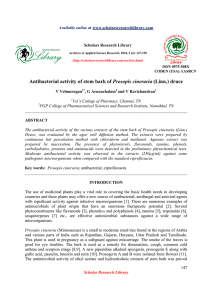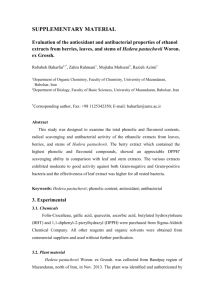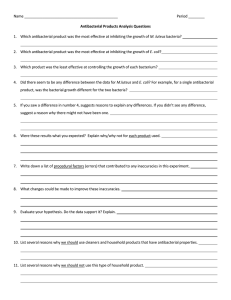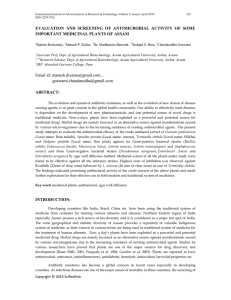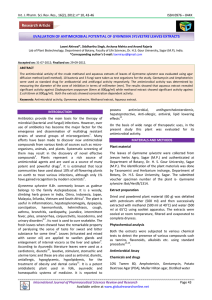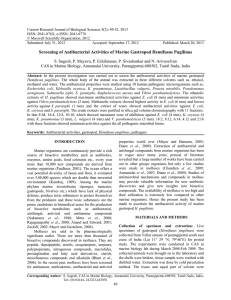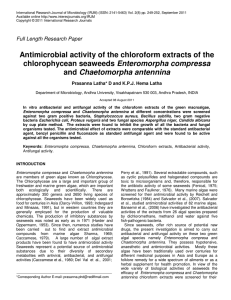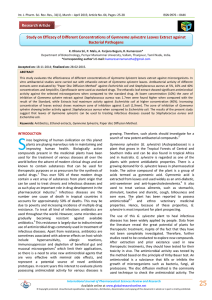Document 13308510
advertisement
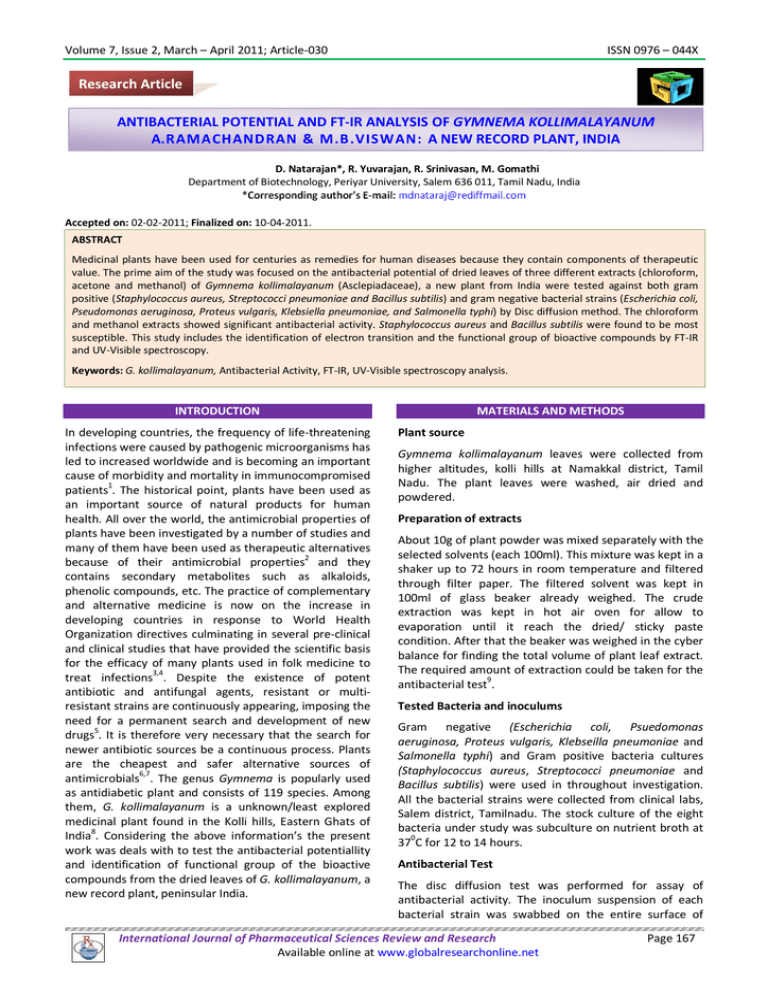
Volume 7, Issue 2, March – April 2011; Article-030 ISSN 0976 – 044X Research Article ANTIBACTERIAL POTENTIAL AND FT-IR ANALYSIS OF GYMNEMA KOLLIMALAYANUM A.RAMACHANDRAN & M.B.VISWAN: A NEW RECORD PLANT, INDIA D. Natarajan*, R. Yuvarajan, R. Srinivasan, M. Gomathi Department of Biotechnology, Periyar University, Salem 636 011, Tamil Nadu, India Accepted on: 02-02-2011; Finalized on: 10-04-2011. ABSTRACT Medicinal plants have been used for centuries as remedies for human diseases because they contain components of therapeutic value. The prime aim of the study was focused on the antibacterial potential of dried leaves of three different extracts (chloroform, acetone and methanol) of Gymnema kollimalayanum (Asclepiadaceae), a new plant from India were tested against both gram positive (Staphylococcus aureus, Streptococci pneumoniae and Bacillus subtilis) and gram negative bacterial strains (Escherichia coli, Pseudomonas aeruginosa, Proteus vulgaris, Klebsiella pneumoniae, and Salmonella typhi) by Disc diffusion method. The chloroform and methanol extracts showed significant antibacterial activity. Staphylococcus aureus and Bacillus subtilis were found to be most susceptible. This study includes the identification of electron transition and the functional group of bioactive compounds by FT-IR and UV-Visible spectroscopy. Keywords: G. kollimalayanum, Antibacterial Activity, FT-IR, UV-Visible spectroscopy analysis. INTRODUCTION In developing countries, the frequency of life-threatening infections were caused by pathogenic microorganisms has led to increased worldwide and is becoming an important cause of morbidity and mortality in immunocompromised patients1. The historical point, plants have been used as an important source of natural products for human health. All over the world, the antimicrobial properties of plants have been investigated by a number of studies and many of them have been used as therapeutic alternatives because of their antimicrobial properties2 and they contains secondary metabolites such as alkaloids, phenolic compounds, etc. The practice of complementary and alternative medicine is now on the increase in developing countries in response to World Health Organization directives culminating in several pre-clinical and clinical studies that have provided the scientific basis for the efficacy of many plants used in folk medicine to treat infections3,4. Despite the existence of potent antibiotic and antifungal agents, resistant or multiresistant strains are continuously appearing, imposing the need for a permanent search and development of new drugs5. It is therefore very necessary that the search for newer antibiotic sources be a continuous process. Plants are the cheapest and safer alternative sources of 6,7 antimicrobials . The genus Gymnema is popularly used as antidiabetic plant and consists of 119 species. Among them, G. kollimalayanum is a unknown/least explored medicinal plant found in the Kolli hills, Eastern Ghats of India8. Considering the above information’s the present work was deals with to test the antibacterial potentiallity and identification of functional group of the bioactive compounds from the dried leaves of G. kollimalayanum, a new record plant, peninsular India. MATERIALS AND METHODS Plant source Gymnema kollimalayanum leaves were collected from higher altitudes, kolli hills at Namakkal district, Tamil Nadu. The plant leaves were washed, air dried and powdered. Preparation of extracts About 10g of plant powder was mixed separately with the selected solvents (each 100ml). This mixture was kept in a shaker up to 72 hours in room temperature and filtered through filter paper. The filtered solvent was kept in 100ml of glass beaker already weighed. The crude extraction was kept in hot air oven for allow to evaporation until it reach the dried/ sticky paste condition. After that the beaker was weighed in the cyber balance for finding the total volume of plant leaf extract. The required amount of extraction could be taken for the antibacterial test9. Tested Bacteria and inoculums Gram negative (Escherichia coli, Psuedomonas aeruginosa, Proteus vulgaris, Klebseilla pneumoniae and Salmonella typhi) and Gram positive bacteria cultures (Staphylococcus aureus, Streptococci pneumoniae and Bacillus subtilis) were used in throughout investigation. All the bacterial strains were collected from clinical labs, Salem district, Tamilnadu. The stock culture of the eight bacteria under study was subculture on nutrient broth at 0 37 C for 12 to 14 hours. Antibacterial Test The disc diffusion test was performed for assay of antibacterial activity. The inoculum suspension of each bacterial strain was swabbed on the entire surface of International Journal of Pharmaceutical Sciences Review and Research Available online at www.globalresearchonline.net Page 167 Volume 7, Issue 2, March – April 2011; Article-030 ISSN 0976 – 044X Mueller-Hinton agar (MHA, HiMedia). The filter paper discs (6-mm) were aseptically placed on MHA surfaces and crude extracts were immediately added to discs (in volumes of 30 µl). The plates were left at ambient temperature for 15 minutes to allow the excess prediffusion of extracts prior to incubation at 37°C for 24 hrs. The diameter of inhibition zones were measured10. The standard antibiotics i.e. Streptomycin (10µg) for gram positive and Penicillin (10µg) for gram negative bacterial cultures. UV Visible spectrum study Nonlinear optical property of the plant sample has been tested by Kurtz powder technique. Its optical behavior was examined by Ultraviolet-vis spectrum instrument model Lambda 35 and found that the crystal is 11 transparent in the region between 380–900 nm . FT-IR analysis The FT-IR analysis of ethanolic extracts of plant samples by using BRUKER 1FS 66U model FT-IR and FT Raman spectrometer using KBr pellet and powder form respectively. The FT-IR was recorded in the range 4004000cm-1. The assignments were made assuming Cs point group symmetry. The various modes of vibration were identified and assigned. In the report was apart from the fundamental bands; some more bands found in the spectra are attributed to overlapping combinations and lattice vibration12. RESULTS AND DISCUSSION The extractive value of powdered leaves of G.kollimalayanum was showed higher in methanol extract (1.32g), followed by chloroform (0.48g) and acetone (0.26g). The chloroform and methanol extracts of this plant expressed significant antibacterial activity. Out of eight bacterial cultures, S. aureus and B. subtilis have found to be remarkable activity (Figure 1; Table 1). Table 1: Antibacterial assay of Gymnema kollimalayanum leaves Zone of Growth Inhibition (diameter in mm) Pathogens → Extracts ↓ Methanol Chloroform Acetone Streptomycin Penicillin B.subtilis P.aeruginosa S.aureus K.pneumoniae S.typhi S.pneumoniae E.coli P.vulgris 11 11 21 - 9 7 9 18 - 10 9 8 22 - 8 8 11 12 - 9 7 7 15 - 8 9 8 18 - 8 10 8 - 11 8 11 13 - Figure 1: Antibacterial Activity of leaf extracts of G. kollimalayanum International Journal of Pharmaceutical Sciences Review and Research Available online at www.globalresearchonline.net Page 168 Volume 7, Issue 2, March – April 2011; Article-030 The acetone extracts showed broad spectrum of antibacterial activity against the tested bacterial pathogens than other solvents. Similarly, the ethanolic extract of G. sylvestre leaves showed good antimicrobial activity against Bacillus pumilis, B. subtilis, Pseudomonas aeruginosa and Staphylococcus aureus13. Other earlier report focused on five different organic solvents and aqueous extracts of Gymnema montanum leaves were screened for their antimicrobial activities and the results (ethanol and hexane extracts) showed significant antimicrobial activity against Salmonella typhi, Pseudomonas aeruginosa and Candida albicans14. The FT- S.No 1 2 3 4 5 6 7 Peak value 3952.53 3804.24 3405.51 2923.21 2350.27 2155.33 1640.17 8 9 10 1396.04 1046.09 654.79 S.No 1 2 3 ISSN 0976 – 044X IR and UV spectrum was used to identify the functional group of the active components based on the Peak value in the region of infrared radiation. The ethanol extract of G.kollimalayanum was passed into the FTIR, the functional groups of the components were separated based on its peak ratio and the same was passed into UV spectroscopy for the electron transition of compounds. The results of FT-IR analysis was confirmed the presence of the carboxylic acid and Alkenes-CH2; CH3 Aromatic stretching which shows major peaks at 1019.87 and 2922.33cm-112 (Table 2, 3 & Fig 2 & 3). Table 2: FT-IR Peak value and its functional groups Functional group N-H Stretching in resonance with overtone. Alcohol O-H stretching (Alcohol and Phenols), oxygen – containing. Si-OH Stretching (Silicon Compound) Aliphatic C-H stretching (Aldehydes and ketones), oxygen containing. Phosphorus acid and ester P-H stretching (Phosphorus compounds) Aliphatic ISO nitrile –N C stretching (nitrogen – containing) Secondary amide C=O stretching (amides), nitrate No2 asymmetric stretching (nitrogen-containing). Combination C-H stretching (organic compound) Aliphatic asymmetric P-O-C stretching (Phosphorus compounds) Secondary amide N-H usagging (amides) Table 3: UV Visible spectroscopy Peak value and its transition Peak value Functional group 413.77 n π* transition due to –OH group 469.15 Visible region 664.43 Visible region Figure 2: UV spectrum of Ethanol Extract of G. kollimalayanum International Journal of Pharmaceutical Sciences Review and Research Available online at www.globalresearchonline.net Page 169 Volume 7, Issue 2, March – April 2011; Article-030 ISSN 0976 – 044X Figure 3: FT-IR analysis of Ethanol extract of G. kollimalayanum The present investigation was concluded that G. kollimalayanum (Asclepiadaceae) is one of the valuable plant and three different organic solvents (chloroform, acetone and methanol) extracts of G.kollimalayanum leaves were screened for their antibacterial activities against eight human pathogenic bacterial strains (Staphylococcus aureus, Streptococci pneumoniae, Bacillus subtilis, E.coli, Pseudomonas aeruginosa, Proteus vulgaris, Klebsiella pneumoniae, and Salmonella typhi). Among the different extracts tested, chloroform and methanol extracts showed significant antibacterial activities. The ethanol extract was passed into the FTIR and UV radiation for the separation of the functional groups of the bioactive components based on its peak ratio and electron transition of compounds respectively. This study suggests that further research will be needed for pharmacological aspects of this taxon. Acknowledgements: The authors are grateful to Department of Biotechnology, Periyar University, Salem for providing infrastructure to carry out research work. REFERENCES 1. 2. 3. Al-Bari MA, Sayeed MA, Rahman MS, Mossadik MA. Characterization and antimicrobial activities of a phenolic acid derivative produced by Streptomyces bangladeshiensis, a novel species collected in Bangladesh. Res. J Med. & Medical Sci. 2006; 1: 77-81. Adriana B, Almodóvar1 ANM, Pereira1 CT, Mariângela TA. Antimicrobial efficacy of Curcuma zedoaria extract as assessed by linear regression compared with commercial mouthrinses. Brazilian J Microbiol. 2007; 38:440-445. Vijaya K, Ananthan S. Microbiological screening of Indian medicinal plants with special reference to enteropathogens. J Altern Complement Med. 1997; 3:1320. 4. Dilhuydy JM. Patients attraction to complementary and alternative medicine (CAM): a reality which physicians can neither ignore nor deny. Bulletin Cancer 2003; 90:623-628. 5. Silver LL. Discovery and development of new antibiotics: the problem of antibiotic resistance. Antimicrobial Agents Chemother. 1993; 37: 377-383. 6. Pretorius CJ, Watt E. Purification and identification of active components of Carpobrotus edulis L. J Ethnopharmarcol. 2001;76:87-91. 7. Doughari JH, El-mahmood AM, Manzara S.. Studies on the antibacterial activity of root extracts of Carica papaya L. African J Microbiol Res. 2007; 037- 041. 8. Ramachandran A, Viswanathan MB. A new species of Gymnema (Asclepiadaceae) from the Kollihills in Peninsular India. Adansonia, sér. 3, 2009; 31: 407-411. 9. Smania A, Monache DF, Gil ML, Benchetrit LC, Cruz FS. Antibacterial activity of substance produced by the fungus Pycnoporuis sanguineus (Fr) Merr. J. Ethnopharmacol. 1995; 45: 177-181. 10. Jairaj P, Khoohaswan P, Wongkrajang Y, Peungrisha P, Suriyawong P, Saraya S, Ruangsonboon O. Anticough and antimicrobial activities of Psidium guajava Linn. Leaf extract. J Ethnopharmacol. 1999; 67: 203-212. 11. Rachh PR, Rachh MR, Soniwala MM, Joshi VD, Suthar AP. Effect of Gymnema Leaf extract on UV-Induced Damage on Salmonella typhi., Asian J Biol. Sci. 2010; 3: 28-33. 12. Karthishwaran K, Mirunalini S, Dhamodharan G, Krishnaveni M, Arulmozhi. Phytochemical investigation of methanolic extract of the leaves of Pergularia daemia. J Biol. Sci. 2010; 10: 242-246. 13. Satdivea RK, Abhilashb P, Fulzele PD. Antimicrobial activity of Gymnema sylvestre leaf Extract. Fitoterapia 2003; 74: 699–701. 14. Ramkumar KM, Rajaguru P, Ananthan R. Antimicrobial Properties and Phytochemical Constituents of an Antidiabetic Plant Gymnema montanum. Ad. Biol.Res.2007; 1: 67-71. ************** International Journal of Pharmaceutical Sciences Review and Research Available online at www.globalresearchonline.net Page 170
